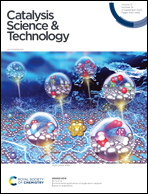Active vanadium(iv) species synthesized at low-temperature facilitate excellent performance in low-temperature NOx-catalytic removal†
Abstract
Vanadium-based catalysts have been extensively used to catalyze various reactions, for example, their long-term application in the de-NOx process. Various vanadium species dispersed on carriers with a large surface area act as catalytic active sites. However, the role of crystal V2O5 in the selective catalytic reduction of NOx by NH3 remains unclear. In this study, a series of bulk vanadium oxide catalysts were synthesized by varying the synthesis temperature, among which the catalyst with a large amount of crystalline V2O5 synthesized at low temperatures exhibited excellent NH3-selective catalytic reduction (NH3-SCR) activity at low temperatures. It was found for the first time that V4+ species in this catalyst play an important role in low-temperature NH3-SCR, which significantly improved the catalytic performance at low temperatures. The difference in the NH3 activation of V2O5 with different ratios of V4+/V5+ was investigated by NH3 temperature-programmed desorption (TPD) and in situ diffuse reflectance Fourier transform infra-red (IR-DRIFT) tests. The difference in O2 activation was studied by O2-TPD and 18O2 isotope exchange experiments. The results show that a higher proportion of V4+ is more conducive to NH3 and O2 activation. This discovery provides a basic understanding of chemical reactions catalyzed by metal oxides and is of great significance for the development and commercial application of NH3-SCR catalysts.



 Please wait while we load your content...
Please wait while we load your content...